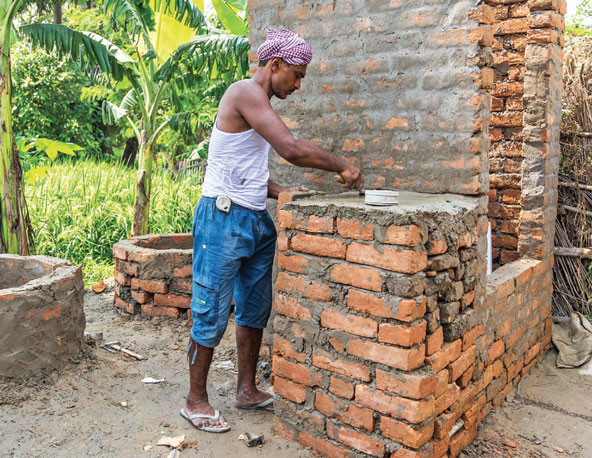 A mason trained by AKDN builds
a toilet for a family in Muzaffarpur
district in Bihar state. (Photo by Christopher Wilton-Steer, courtesy of AKDN)
A mason trained by AKDN builds
a toilet for a family in Muzaffarpur
district in Bihar state. (Photo by Christopher Wilton-Steer, courtesy of AKDN)

Two years ago, India’s prime minister, Narendra Modi, made a bold statement: India, he said, would eliminate open defecation by October 2019. To accomplish this enormous goal, the Indian government aspires to build 120 million toilets in rural India. The budget for the massive public project, which is referred to as Swachh Bharat Abhiyan (Clean India Mission), is INR 200,000 crores ($29 billion).
The solution, though, is not as simple as just handing out free toilets. The people of India need to be compelled to change long-entrenched habits as well. As the Aga Khan Development Network (AKDN) argues, it will take a three-pronged solution—a combination of funds, raw materials, and human capital—with India’s citizens fully engaged on each front, to yield a successful rollout of toilets across India.
To that end, several agencies of AKDN have been working with India’s government to develop more community-driven approaches to building toilets in villages. Specifically, between 2015 and 2019 the Aga Khan Foundation, the Aga Khan Rural Support Programme, Aga Khan Health Services, and the Aga Khan Agency for Habitat are facilitating access to sanitation for 100,000 families as well as improving water, sanitation, and hygiene in 538 schools. AKDN is working in the states of Bihar, Gujarat, Madhya Pradesh, and Uttar Pradesh, and plans to expand to Hyderabad and Maharashtra.
Asad Umar is the senior program officer for health at the Agha Khan Foundation and responsible for this extensive project. He has seen charitable organizations dole out toilets in the past. As he says, “Clearly, building toilets works only when people use them, and usage is only possible when communities are involved in the planning, construction, and maintenance of toilet facilities.”
Finding the Money
AKDN’s approach is aligned with the implementation strategy of the Indian government; that success rests in part on compelling communities to help build their own toilets. And with that approach in mind, the government’s Swachh Bharat campaign has set up a INR 12,000 ($175) subsidy for each household to buy construction materials for a toilet. Unfortunately, those funds are released only after the toilet is constructed, a practice that Umar says can be problematic. “One of the biggest challenges the poor and the marginalized face in constructing toilets is lack of money.”
To help people get the initial capital they need to construct a toilet, AKDN has established a revolving fund in Madhya Pradesh through local village institutions. Families in tribal communities can tap into the fund for an interest-free loan to buy raw materials and pay masons. Once the toilet is complete, they pay back the loan by depositing their entire government subsidy into the fund. So far, only families who qualify for the government subsidy are eligible to participate. But even this limited effort has made a notable difference. In six months, the fund has enabled approximately 620 households in 11 villages to have toilets.
Now, given the success of the model, AKDN is encouraging more communities to find sustainable and community-based ways to finance the construction of toilets. The key, Umar explains, is to make sure the community does not fall into debt while financing the construction of toilets. “They do not want to take a loan from local moneylenders who charge high interest rates.”
Human Capital and Raw Materials
Even with funding, AKDN has noticed that locals needed better supplies and more help to construct toilets that meet government guidelines. While the government already runs a number of shops that sell construction materials and toilets (Rural Sanitary Markets, or RSMs), these outlets are often low on stock. “That’s because demand is low,” Umar says. “RSMs have been unsuccessful in making toilet construction easier and have not been economically viable for the local entrepreneurs managing them.”
To drum up more interest in building toilets, AKDN held a series of community meetings and street plays around one of the RSMs in the state of Bihar. The network also facilitated wall paintings in the area that illustrate messages pertaining to sanitation. The results were positive. “We saw an increase in demand for toilet construction,” says Umar. What’s more, the RSMs are now linked to a network of masons; customers are more likely to shop there these days because they get access to masons as well as raw materials. As of this writing, in the seven locations where AKDN is promoting RSMs, more than 4,000 units have been constructed.
The third prong of AKDN’s sanitation efforts involves training more masons in order to build a larger network of skilled people who can build toilets according to government guidelines. To date, the network has trained 601 masons in four states using three-day-long courses that go over the details of installing toilets and also stress the importance of the job. “With large-scale toilet construction activities, trained masons are more in demand,” Umar notes, and now district officials in Uttar Pradesh and Madhya Pradesh are asking AKDN for help in training new masons.
While it may be tempting to simply install toilets throughout India, Umar says, the answer to India’s sanitation problem rests on citizen engagement: “The proposed sanitation initiative will be successful only if communities understand the health, educational, and economic benefits of improved sanitation and adopt it themselves.”
Support SSIR’s coverage of cross-sector solutions to global challenges.
Help us further the reach of innovative ideas. Donate today.
Read more stories by Esha Chhabra.

